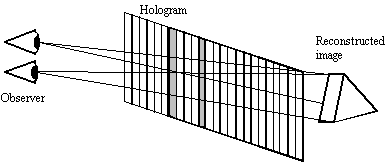How Lasers and Light Waves Make Holograms
Most of the information
that reaches us comes in the form of waves, sound and light. A unique feature
of our perception of light wave information is that we perceive an object
to be at a distance; an object appears to be located a distinct place in
space. Holography is the means of storing this wave information and reproducing
that information in such a way that none of that information is lost. So a
question arises: “How can we store the wave information in such a way that
that we can reconstruct the original wave information at will and allow our
senses to perceive the objects at a distance?” This is where the interference
pattern of the waves comes into play.
The interference pattern is important because all of the three-dimensional information about the waves is contained in the two-dimensional sample. Waves that are forced to conform to the original waves on a two dimensional surface will thereafter duplicate the behavior of the original waves. Basically, when you shine a light on the hologram, you see the recorded image. No three-dimensional information is lost on the two-dimensional sampling. The problem of recreating a three-dimensional copy of the waves is reduced to that of reconstructing the wave front on any two-dimensional surface.
So, if the two-dimensional surface is a finite surface, that is, it is not infinitely large, some of the original wave data, the interference pattern, is not recorded and therefore reconstructed. This is because there are an infinite possible of interference patterns; light is bouncing off of the object from an infinite number of angles and directions, all of this information simply cannot be recorded. Therefore, the three-dimensional reconstruction cannot possibly be an exact copy of the original. The reconstructed image is in fact the sum off all the waves, which have the same interference pattern as the finite two-dimensional surface that is recording the wave information.
Lets think about how to record the interference pattern. To record this pattern, there must be some point of reference by which all of the waves can be measured. A regular light bulb put out light at many frequencies and wavelengths, so it would be impossible to use regular light as a reference by which we can measure the interference pattern. So, we need light that is more organized. This is where the Laser comes in to play.
The interference pattern is important because all of the three-dimensional information about the waves is contained in the two-dimensional sample. Waves that are forced to conform to the original waves on a two dimensional surface will thereafter duplicate the behavior of the original waves. Basically, when you shine a light on the hologram, you see the recorded image. No three-dimensional information is lost on the two-dimensional sampling. The problem of recreating a three-dimensional copy of the waves is reduced to that of reconstructing the wave front on any two-dimensional surface.
So, if the two-dimensional surface is a finite surface, that is, it is not infinitely large, some of the original wave data, the interference pattern, is not recorded and therefore reconstructed. This is because there are an infinite possible of interference patterns; light is bouncing off of the object from an infinite number of angles and directions, all of this information simply cannot be recorded. Therefore, the three-dimensional reconstruction cannot possibly be an exact copy of the original. The reconstructed image is in fact the sum off all the waves, which have the same interference pattern as the finite two-dimensional surface that is recording the wave information.
Lets think about how to record the interference pattern. To record this pattern, there must be some point of reference by which all of the waves can be measured. A regular light bulb put out light at many frequencies and wavelengths, so it would be impossible to use regular light as a reference by which we can measure the interference pattern. So, we need light that is more organized. This is where the Laser comes in to play.
Index
How Lasers and Light Waves make Holograms
